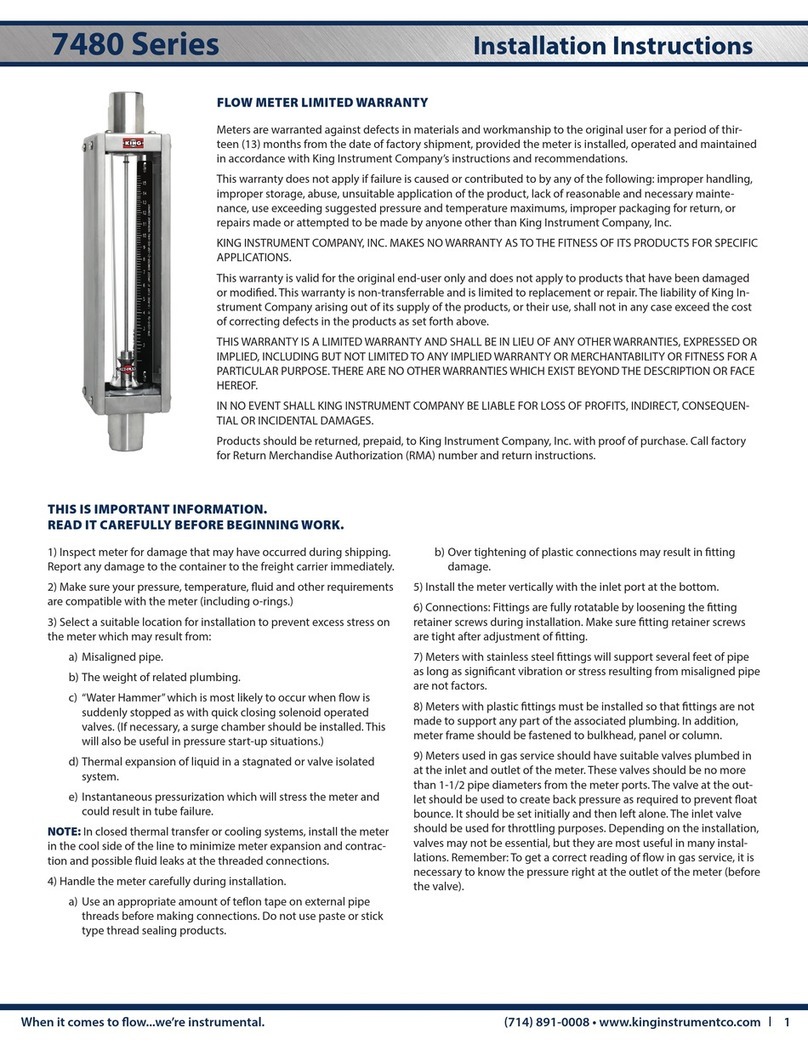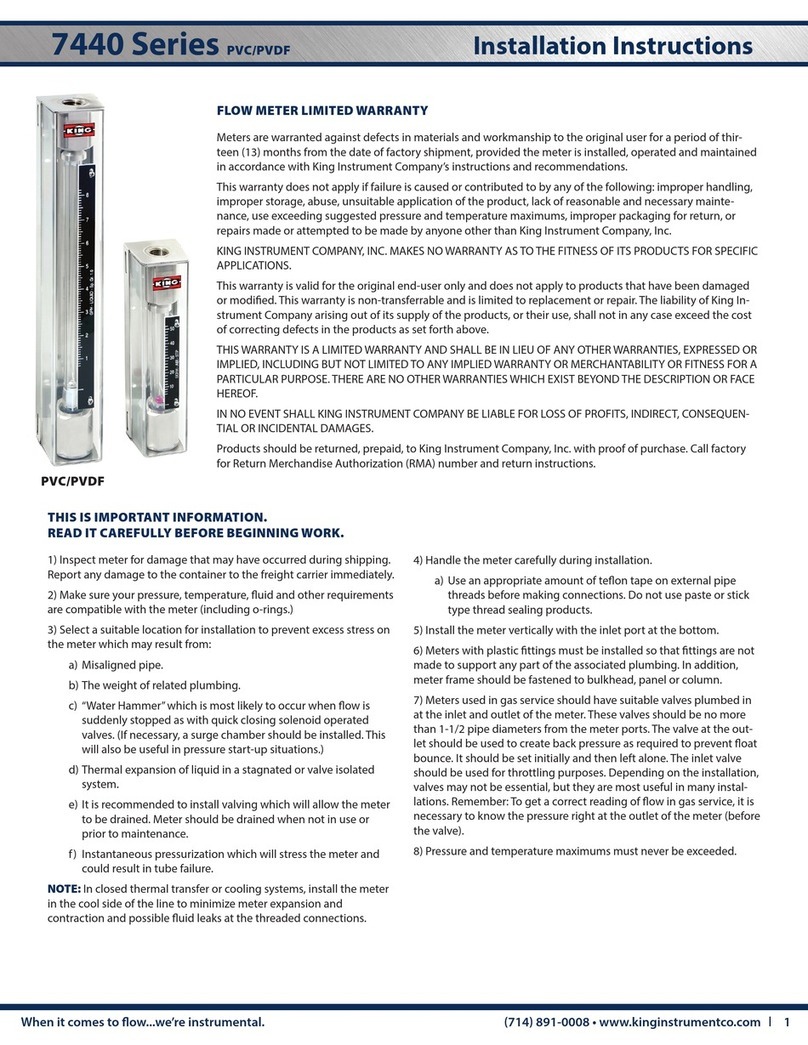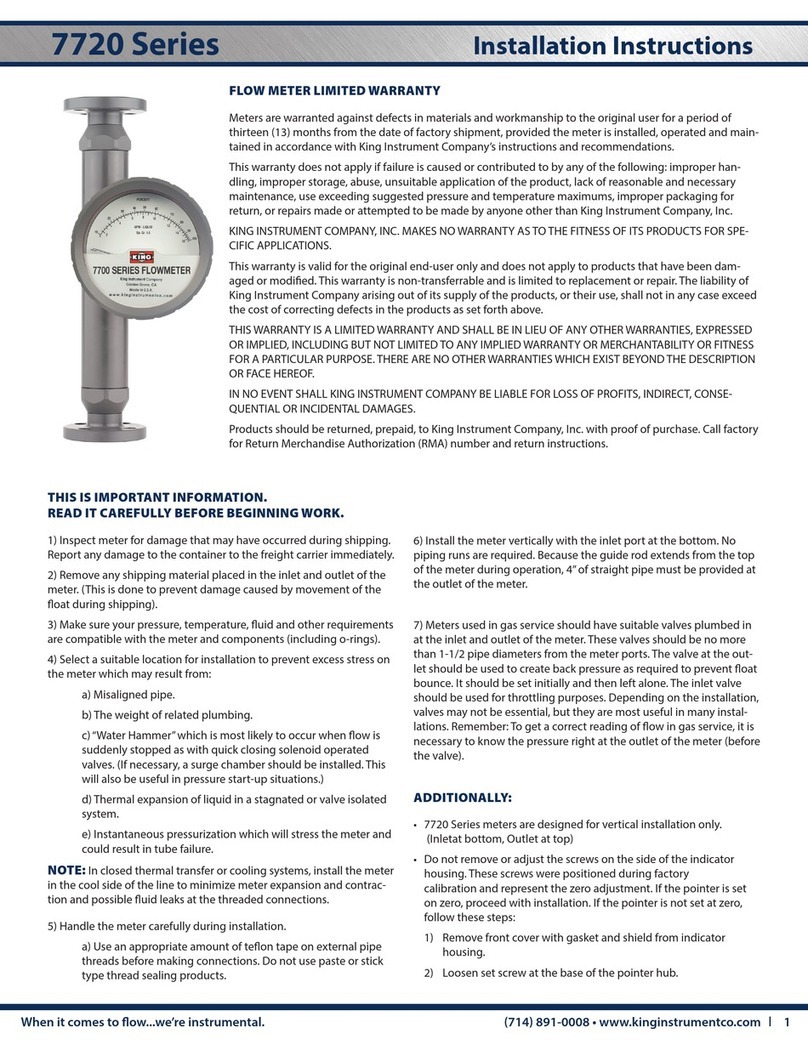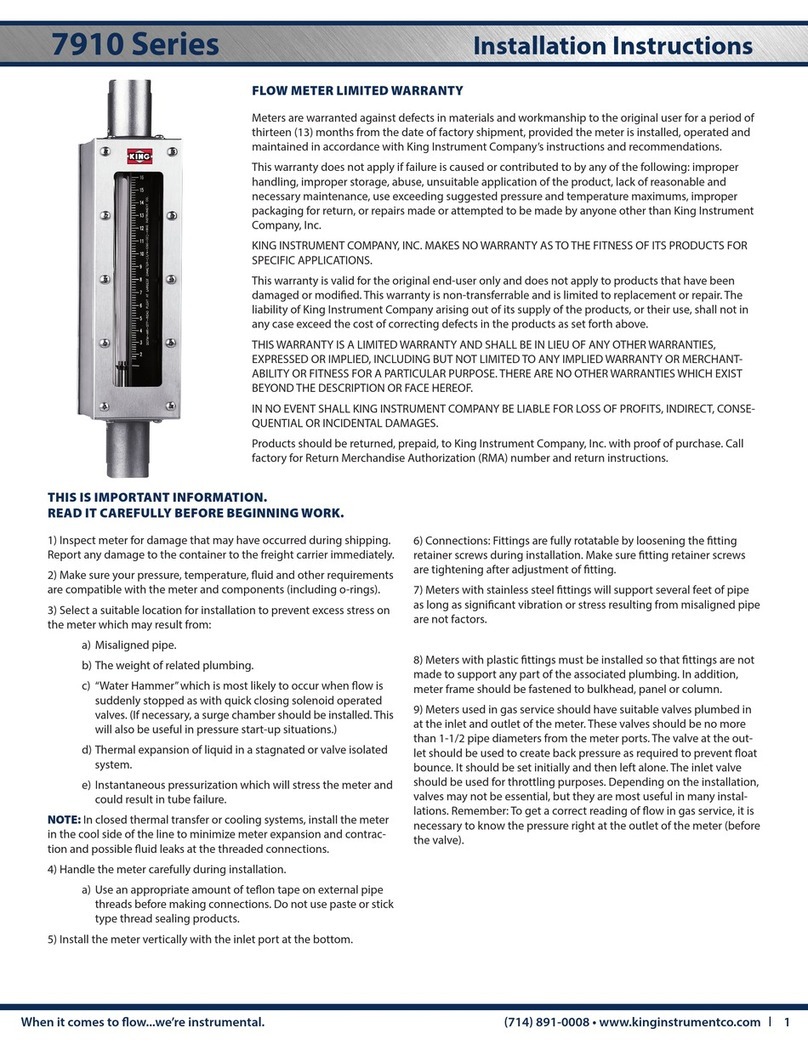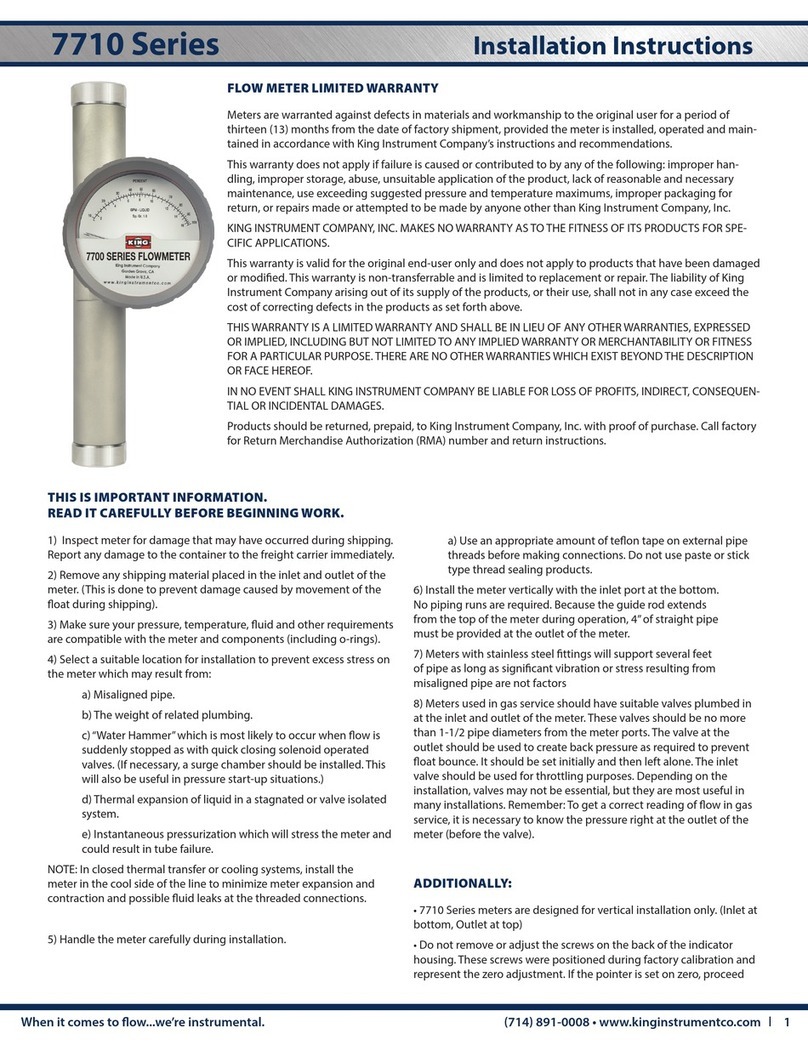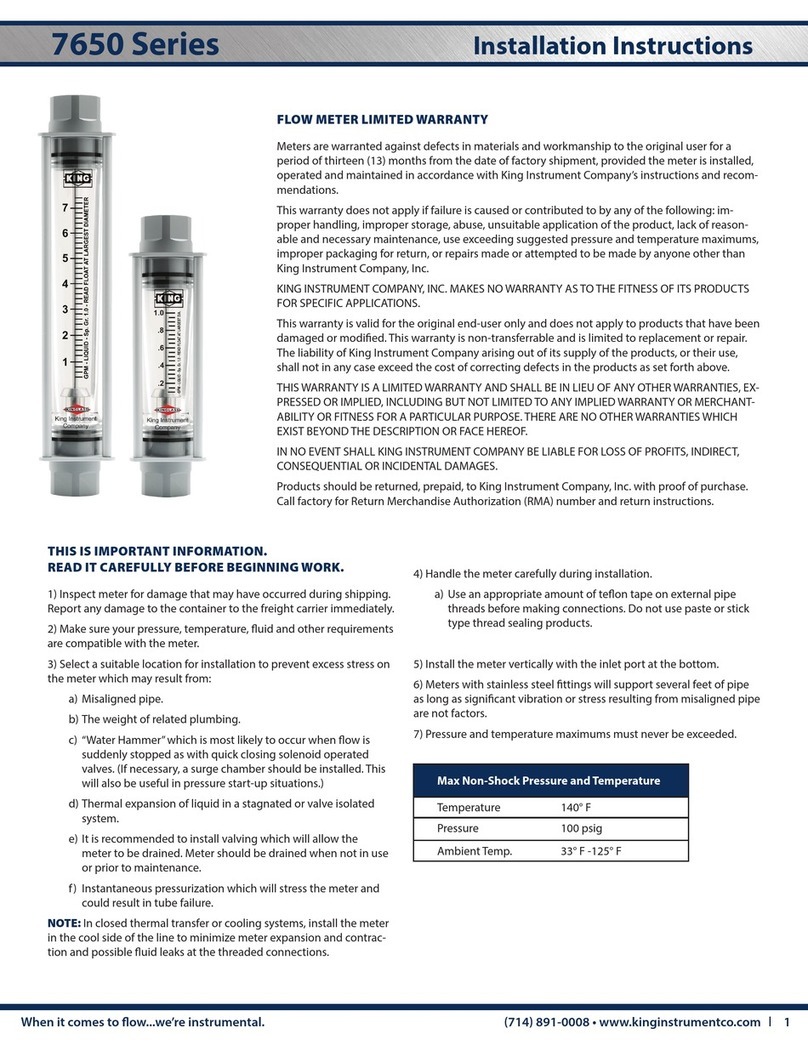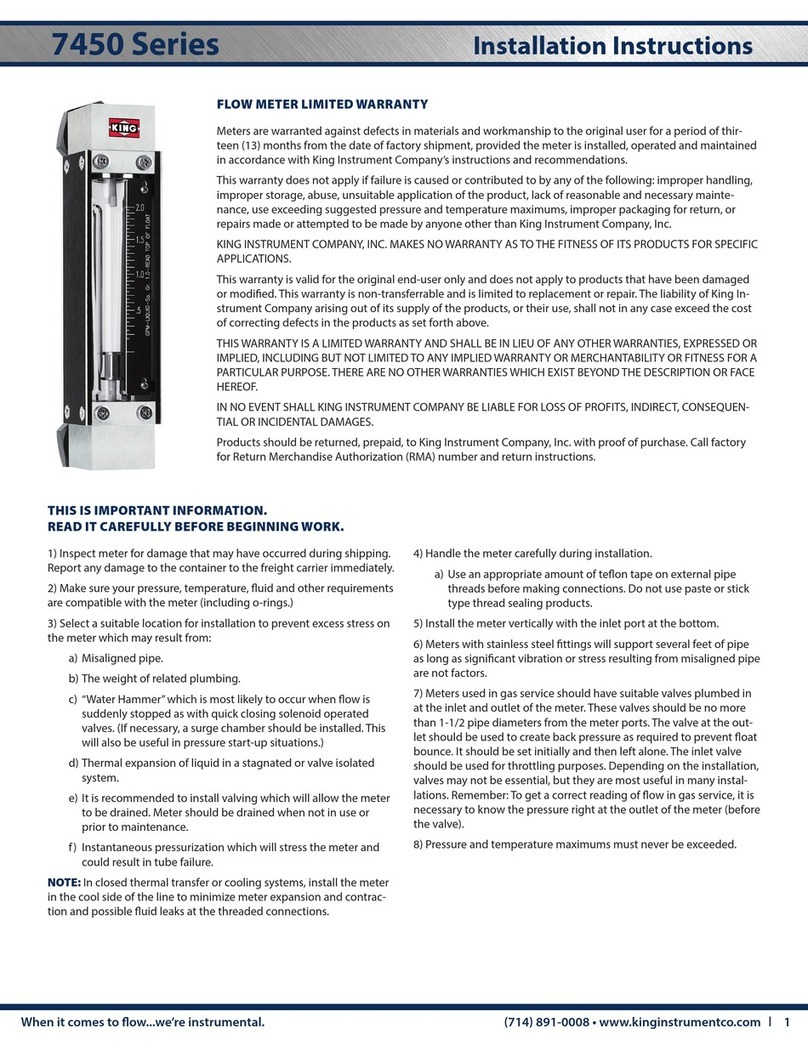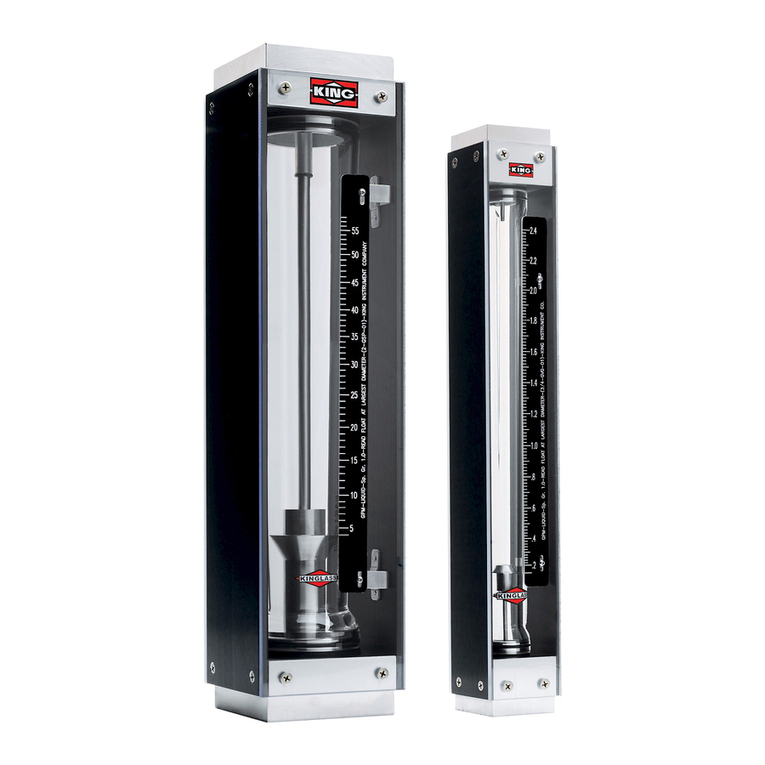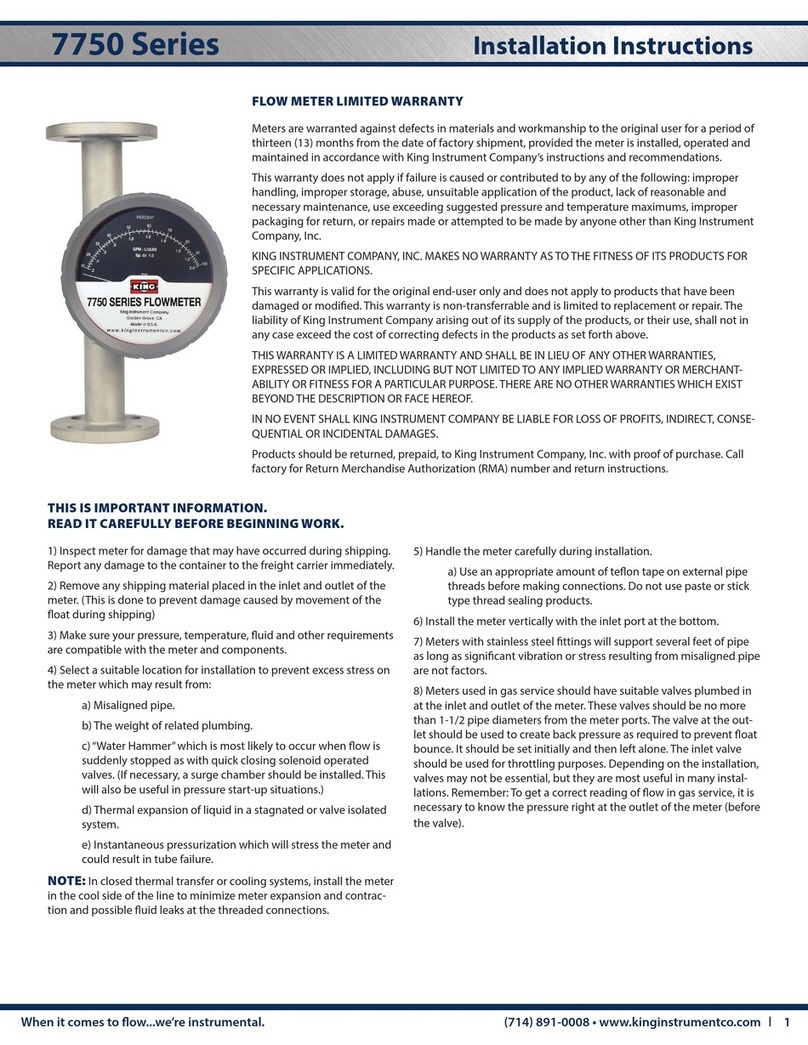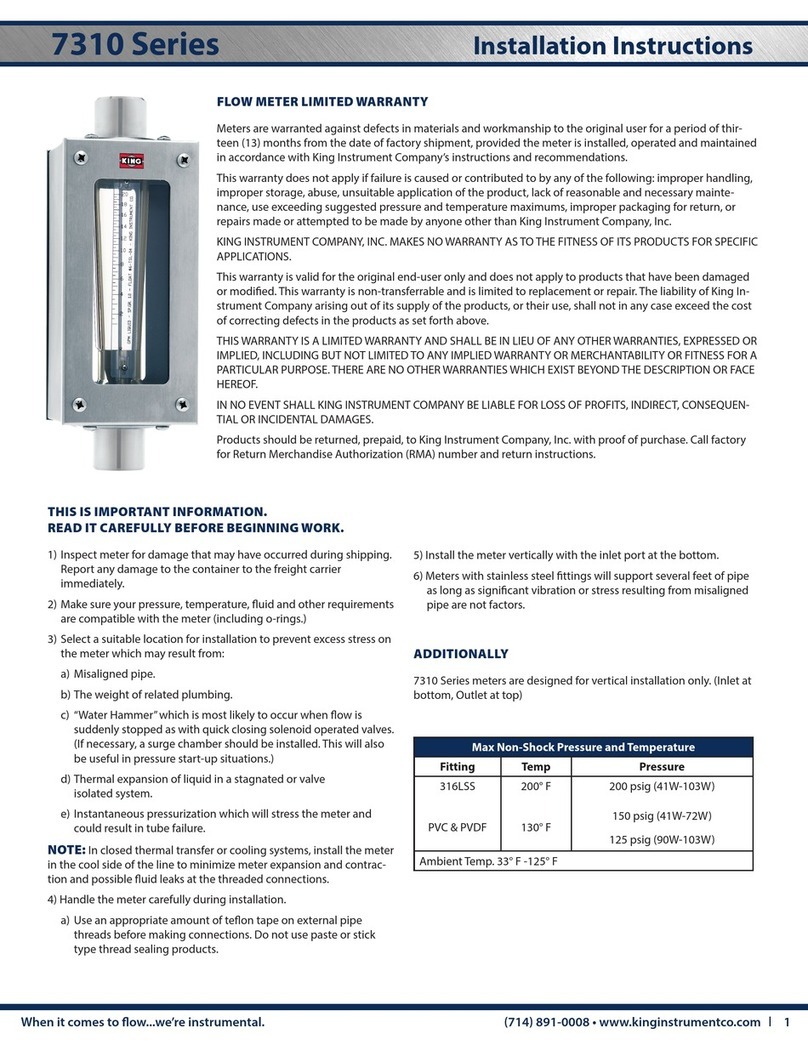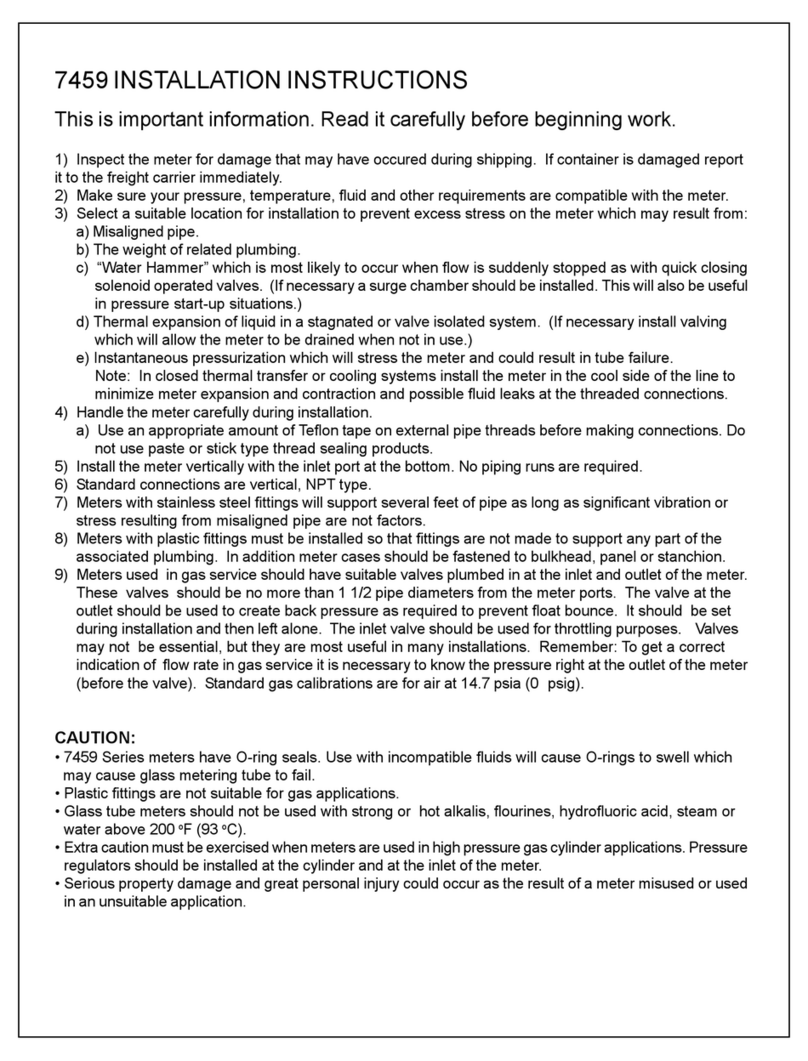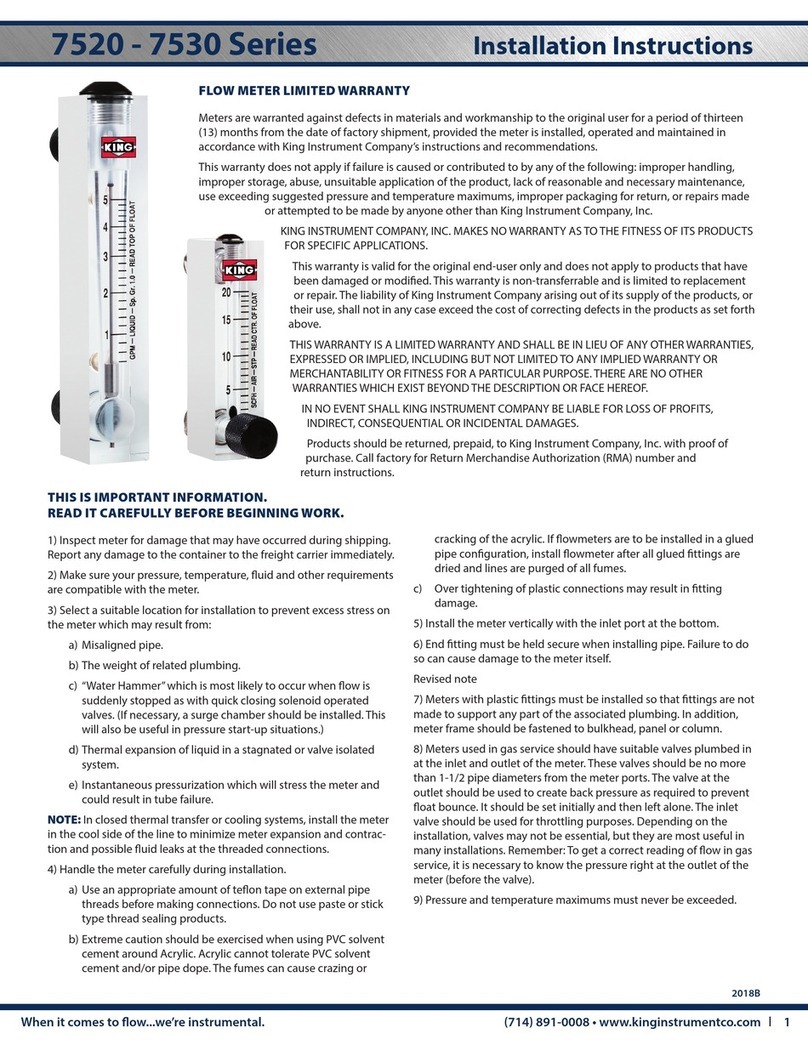
(714) 891-0008 • www.kinginstrumentco.comWhen it comes to ow...we’re instrumental. 2
CAUTION
• 7200 meters are not oxygen cleaned. Use with incompatible uids
may cause o-rings to swell and break.
• O-rings should be replaced if meter is disassembled after it has
been in service.
• Extra caution must be exercised when meters are used in high
pressure gas cylinder applications. Pressure regulators should be
installed at the cylinder and at the inlet of the meter.
• Serious property damage and great personal injury could
occur as the result of a meter misused or used in an
unsuitable application.
CLEANING
Carefully remove the owmeter from piping system. Remove the
threaded outlet tting and withdraw the oat from the top. All neces-
sary instrument components are now fully accessible for cleaning with
a bottle brush and appropriate mild soap solution*. Before the meter is
reassembled, inspect all parts for damage. O-rings should be replaced
during meter maintenance and cleaning.
To reassemble, carefully guide the oat back into the tube. When
installing oat/guide assembly make certain that the end of the guide
fully engages the inlet and/or outlet oat stop. Reinstall and tighten
ttings in appropriate ports. Reinstall the instrument into the plumb-
ing system after removing the old teon tape (with a wire brush) and
replacing with fresh teon tape.
*Do not use cleaning agents that will damage oat, tube or o-rings.
Meters should be cleaned with a mild soap solution. This will be an
eective cleaner of rust stains. Caution must be used so that materials
of construction are not damaged by cleaning solutions. Hard water
deposits can be removed with 5% acetic acid solution (vinegar).
REPAIR
7200 meters that require repair should be sent to the factory. Please
call for a Return Merchandise Authorization (RMA) number and return
instructions.
WARNING:
Pressure and temperature ratings are based on a study of the engi-
neering data for particular materials used in construction and on the
design of individual models. This information is supplemented by
destructive test results. Meters with stainless enclosures must never be
operated without shields securely in place. Meters exposed to dicult
environments such as those created by certain chemicals, excessive
vibration or other stress inducing factors could fail at or below the
suggested maximums. Never operate meters above pressure and
temperature maximums. It is strongly recommended that all meter
installations utilize an appropriate pressure relief valve and/or rupture
disc. The pressure settings and locations of these devices should be
such that meters cannot be over pressurized. Meter failure could
result in damage to equipment and serious personal injury. Always
use suitable safety gear, including OSHA approved eye protection
when working around meters in service. We are happy to pass along
chemical compatibility information that has been published by the
manufacturer’s of raw materials used in our products; however, this
information should not be construed as a recommendation made by
King Instrument Company, Inc. for a specic application.
FLOAT TYPES AND ORIENTATIONS
7200 Series Installation Instructions
Maximum Non-Shock Pressure and Temperature
Fluid Temperature Pressure
Water 130° F 150 psig
Air 100° F 100 psig
Ambient Temp. 33° F -125° F
GV FLOAT SL FLOAT SP FLOAT
END FITTING
END FITTING O-RING
GUIDE ROD ASSEMBLY
FLOAT
ACRYLIC METER TUBE
INLET FLOAT STOP
Pressure and temperature ratings are based on a study of the engineering data
for particular materials used in construction and on the design of individual
models. This information is supplemented by destructive test results. Meters with
stainless enclosures must never be operated without shields securely in place.
Meters exposed to difficult environments such as those created by certain
chemicals, excessive vibration or other stress inducing factors could fail at or
below the suggested maximums. Never operate meters above pressure and
temperature maximums. It is strongly recommended that all meter installations
utilize an appropriate pressure relief valve and/or rupture disc. The pressure
settings and locations of these devices should be such that meters cannot be
over pressurized. Meter failure could result in damage to equipment and serious
personal injury. Always use suitable safety gear, including OSHA approved eye
protection when working around meters in service. We are happy to pass along
chemical compatibility information that has been published by the manufacturer's
of raw materials used in our products; however, this information should not be
construed as a recommendation made by King Instrument Company, Inc. for a
specific application.
Carefully remove the flowmeter from piping system. Remove the threaded outlet
fitting and withdraw the float from the top. All necessary instrument components
are now fully accessible for cleaning with a bottle brush and appropriate mild
soap solution*. Before the meter is reassembled, inspect all parts for damage.
O-rings should be replaced during meter maintenance and cleaning.
To reassemble, carefully guide the float back into the tube. When installing
float/guide assembly make certain that the end of the guide fully engages the
inlet and/or outlet float stop. Reinstall and tighten fittings in appropriate ports.
Reinstall the instrument into the plumbing system after removing the old teflon
tape (with a wire brush) and replacing with fresh teflon tape.
*Do not use cleaning agents that will damage float, tube or o-rings.
Meters should be cleaned with a mild soap solution. This will be an effective
cleaner of rust stains. Caution must be used so that materials of construction are
not damaged by cleaning solutions. Hard water deposits can be removed with 5%
acetic acid solution (vinegar).
7200 meters that require repair should be sent to the factory. Please call for a
Return Merchandise Authorization (RMA) number and return instructions.
-7200 meters are not oxygen cleaned. Use with incompatible fluids may cause
o-rings to swell and break.
-O-rings should be replaced if meter is disassembled after it has been in service.
-Extra caution must be exercised when meters are used in high pressure gas
cylinder applications. Pressure regulators should be installed at the cylinder and
at the inlet of the meter.
-Serious property damage and great personal injury could occur as the result of a
meter misused or used in an unsuitable application.
1) Inspect meter for damage that may have occurred during shipping.
Report any damage to the container to the freight carrier immediately.
This is important information. Read it carefully
before beginning work.
2) Make sure your pressure, temperature, fluid and other
requirements are compatible with the meter.
3) Select a suitable location for installation to prevent excess stress
on the meter which may result from:
a) Misaligned pipe.
b) The weight of related plumbing.
c) "Water Hammer" which is most likely to occur when flow is
suddenly stopped as with quick closing solenoid operated valves.
(If necessary, a surge chamber should be installed. This will also be
useful in pressure start-up situations.)
d) Thermal expansion of liquid in a stagnated or valve isolated
system.
e) Instantaneous pressurization which will stress the meter and
could result in tube failure.
NOTE: In closed thermal transfer or cooling systems, install the meter
in the cool side of the line to minimize meter expansion and
contraction and possible fluid leaks at the threaded connections.
4) Handle the meter carefully during installation.
a) Use an appropriate amount of teflon tape on external pipe
threads before making connections. Do not use paste or stick type
thread sealing products.
b) Extreme caution should be exercised when using PVC solvent
cement around Acrylic. Solvents can cause acrylic to stress crack.
c) Over tightening of plastic connections may result in fitting
damage.
5) Install the meter vertically with the inlet port at the bottom.
6) Meters with stainless steel fittings will support several feet of pipe
as long as significant vibration or stress resulting from misaligned pipe
are not factors.
7) Meters with plastic fittings must be installed so that fittings are not
made to support any part of the associated plumbing. In addition,
meter frame should be fastened to bulkhead, panel or column.
8) Meters used in gas service should have suitable valves plumbed in
at the inlet and outlet of the meter. These valves should be no more
than 1-1/2 pipe diameters from the meter ports. The valve at the
outlet should be used to create back pressure as required to prevent
float bounce. It should be set initially and then left alone. The inlet
valve should be used for throttling purposes. Depending on the
installation, valves may not be essential, but they are most useful in
many installations. Remember: To get a correct reading of flow in gas
service, it is necessary to know the pressure right at the outlet of the
meter (before the valve).
9) Pressure and temperature maximums must never be exceeded.
EPR 225 °F
Buna-N
Viton
Kalrez
275 °F
350 °F
400 °F
Water
Air
130° F 150 psig
100° F 100 psig
Maximum Non-Shock
Pressure and
Temperature O-Ring Temperature
Ambient
temperature
33° F - 125° F
Viton and Kalrez are registered trademarks of DuPont Dow
Elastomers.
O-Ring Material
PressureTemperature Maximum
Temperature
Meters are not specifically recommended for service other than
water or air. The user must determine meter suitability for use
with other fluids.
GV FLOAT
Highest immunity
to viscous fluids
with medium
meter capacity.
SL FLOAT
Maximum flow
meter capacity
with limited
viscosity immunity
SP FLOAT
Maximum flow
meter capacity
with limited
viscosity immunity
OUTLET FLOAT STOP/
